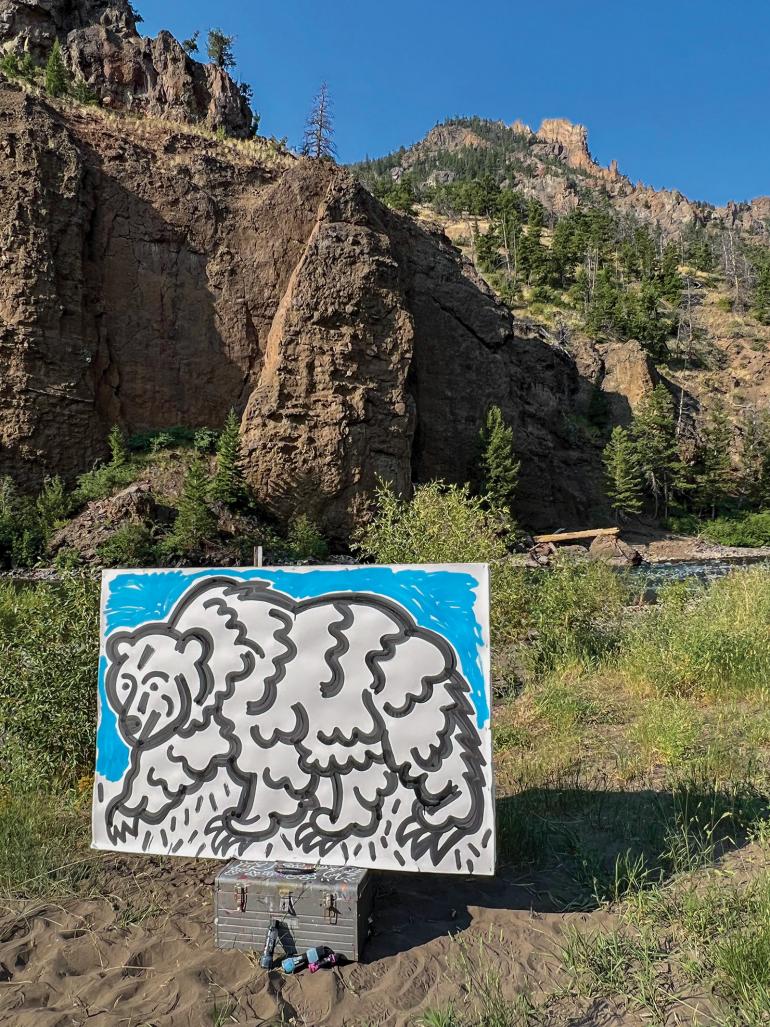Canvassing for Nature
Using street art to protect the GYE.
No standard approach to conservation locates guerrilla street art in context with the West’s iconic backdrops. But Lori Ryker bets her drawing board that a wall mural fronting rush-hour gridlock in Anywhere, America can rouse a screen-scrolling urbanite to champion the wildlands of the Greater Yellowstone Ecosystem (GYE).
Through her “Wildlifes” project, Ryker’s initiative to generate awareness of the GYE through art, mural artist Eric Junker distills the burly biology of native fauna into wall art in cities across the country. Junker’s graffiti-esque images flirt with form while elevating essence. Surfacing into the clamor of everyday experience, they announce themselves as tangible, relevant ideas that implore us to cut through distraction to inform decisions about what we value and how we live.
Packing physical challenge with intellectual invigoration into a van crammed with paints, Erik Junker conveys a visceral intimacy with place into hands-on fieldwork, executing large-format drawings on the fly.
The idea that art can promote a conservation ethic is Yellowstone legend. Artist Thomas Moran’s early landscape depictions influenced the protection of Yellowstone as a national park in 1872, and captured the attention of a nation lured west. But even now, with adjoining wildlands still intact and key species delivered from near-extermination, human pressures are still endangering the persistence of the ecosyetem. If Moran’s art influenced public perception of Yellowstone 150 years ago, what is Wildlife’s updated broadcast?
Get more people to care, says Ryker. Trained as an architect, she pivoted her bellwether design ideas into public art and education to found the Livingston-based nonprofit Artemis Institute in 2003, as a vehicle for exploring the connections between nature and culture.
“We’re dividing everything into parts and pieces,” says Ryker, referring to our patterns of land use, but also our fixation on empirical knowledge. While science and journalism retain vital roles in examining our world, these objective modes of understanding lean on rational thinking that biases our engagement. Art, she says, can trip a switch of raw attention more critical than data-driven analysis.
Junker’s larger-than-life images transcend representation to ignite the primal spark of awareness.
To trip that switch—to resonate—Ryker’s outreach through Artemis Institute immerses artists in remote landscapes to nurture purposeful community design. Launching Wildlifes, she enlisted Junker for an artist residency in the GYE—where he traversed the terrain, chatted with locals, and sponged wisdom from key thinkers. Packing physical challenge with intellectual invigoration into a van crammed with paints, Junker conveyed a visceral intimacy with place into hands-on fieldwork, executing large-format drawings on the fly. His experience birthed Wildlife’s ambassadors—the grizzly bear, gray wolf, bison—and pushed Junker to examine the ways in which we value wildlife.
“It was fascinating to me that those symbols could mean different things to different people. We fetishize animals as symbols tied into the economics of place.”
Junker’s larger-than-life images transcend representation to ignite the primal spark of awareness. But Wildlifes needs to raise more heads. “Talking to ourselves will not save the GYE,” says Ryker. “We’re too small an audience.” To activate broader awareness, she says, target urban centers. Trip more switches.
And urge with an urban voice.
Now based in Los Angeles between metropolitan skyline and the San Gabriels’ highest peaks, Junker draws on an urban vibrancy still swayed by a landscape where grizzlies once roamed. Injecting nature into urban spaces, his murals overcome distraction in a place where “everything has to be a little louder to get attention.”
Which is what conservation needs. Biodiversity loss across growing urban swaths that once bore vaster ecosystems portends the specter of what the GYE could become. To transform thinking about place, Ryker invokes a paradigm shift to redefine the relationship between self and society in a public increasingly removed from wild places. Platforms like Wildlifes penetrate denser population hubs and build more face onto our ideas of connectivity. Public art, she says—when it hits the right place at the right time—can create a contagious experience.
As she seeks mural walls with public presence, posters and prints of Junker’s graphics fund future projects. “That will help me send Eric to London,” says Ryker. But is there conundrum in inviting “outsiders” to prize the GYE’s landscapes pinched by overcrowding and development?
Ryker rejects any qualitative distinction in where conservation lives. The value of Greater Yellowstone’s living core, ancestral as antler or wind, must be embraced as common, Ryker argues. “Outsiders” have been some of the most proactive in saving the region from the get-go. “If you begin to understand that, you see that more people need to value the region instead of dismantling it piece by piece.”
Especially as environmentalists age out. “Current leaders are not broadening their lens for a new generation to re-present and re-think conservation,” says Ryker. “Wildlifes is a step forward to say we’re not going to use the old visual language.” She believes a younger cohort, inspired by a vacuum in conservation’s language of connectivity, will step into the bubble to define wildlife value for themselves.
Recently, on a cinderblock wall in Bozeman, Junker painted a grizzly bear and a bison. The bison spouts a speech bubble of our times, flecked with non-verbal strokes of exclamation, as if beseeching a wider public:
Engage, respond: Fill in the bubble.
To see Eric’s artwork or learn more about the Artemis Institute, visit wildlifes.org or artemisinstitute.org.














